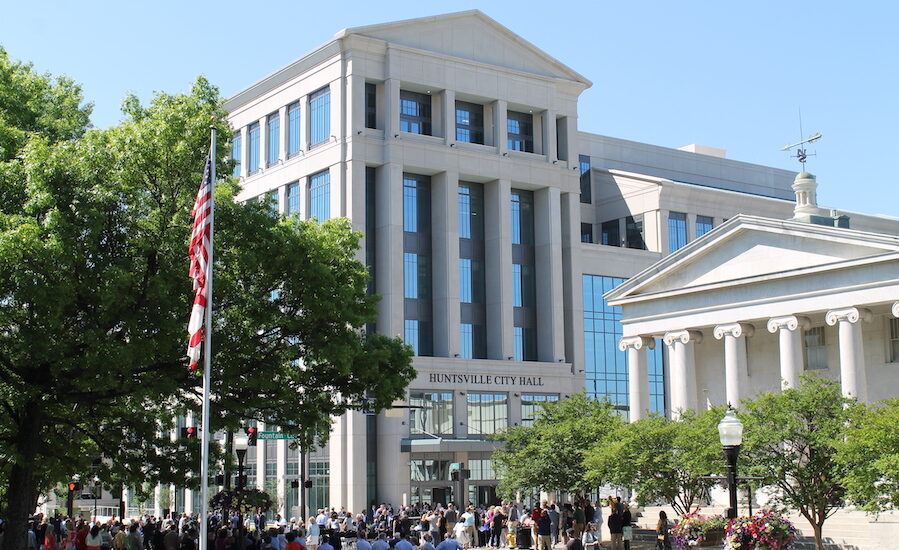
Huntsville Starts a New Chapter with $82M City Hall
Demolition of the former city hall in Huntsville, Ala., is nearing completion, closing one chapter for the city and opening another as its administration settles into its new home, the 175,000-sq-ft Huntsville City Hall that opened in May 2024.
“The visioning for this project goes back nearly 10 years,” said Jeffrey Brewer, CEO of architect Goodwyn Mills Cawood (GMC) at the building’s grand opening, describing the task they were set with in designing the new city hall. “A landmark project like this is not something our team took lightly.”
Long a familiar sight towering over the city’s Big Spring Park, the former city hall building constructed in 1965 is now on its way to becoming a new wing of the park, and it’s the new Huntsville City Hall that’s towering over the city’s central downtown square.
The $82.8-million effort led by Turner Construction kicked off in January 2022 on a steep site formerly home to a 1960s-era parking deck that served the city’s Administration Building, which “everybody called city hall,” says Huntsville City Manager John Hamilton.
The seven-floor Huntsville City Hall is now the headquarters for 365 city government employees, and is joined to a 195,000-sq-ft parking deck hosting 569 spaces for those employees and first-floor public parking. Both were constructed simultaneously.
The Administration Building, now in the midst of a six-month mechanical demolition process, had deteriorated beyond the stage where a refit was feasible, including instances of the building’s marble facade falling. For nearly 20 years, Hamilton notes, wooden structures have been erected on the ground level to protect people from falling marble.
“It was past its sell-by date, and needed to be replaced,” says Mark Coyle, project architect with GMC.
Hamilton says the city also put a priority on longevity, telling GMC that it wanted a building with a usable life of a least 100 years and one that would stand the test of time architecturally as well, something the nearly windowless Administration Building didn’t quite achieve.
“The problem was that [the former building] was about one-third of the size we really needed to serve as a city hall,” Hamilton says. “When you think of it as a group of functions of municipal government, our city hall was scattered among seven locations, of which most—but not all—were downtown.”
Huntsville can now consolidate staff in a much larger building, a boon for city employees and residents alike, Hamilton says, adding “the hope is that we don’t outgrow it as quickly.”
The new Huntsville City Hall is two-and-a-half times the size of the Administration Building, with space allocated to maximize efficiency and floor plates large enough to co-locate city departments that work together, like planning and engineering, formerly spread across three buildings, are now on the same floor.
“Economic Development Director Shane Davis needed to speak with me yesterday,” said Huntsville Mayor Tommy Battle before cutting the ribbon on the new city hall in May 2024. “He didn’t have to walk over a couple buildings, he just came upstairs and popped into the office.”
As developers continue to eye opportunities in Huntsville, they’ll have a smoother experience working with the city, with its engineering and planning departments on the same floor in the same building, as Hamilton notes, it’s the first time the city’s planning department has been in one place.
That’s a philosophy the City Hall applies floor-by-floor, says Hamilton, grouping related departments together to improve capacity and efficiency of city services.
The building features larger council chambers with infrastructure built-in to broadcast into the lobby, providing “a lot more capability for public engagement, something that’s been a bit of a challenge in the past,” Coyle adds.

Shallow rock foundations required the project team to pivot to spread footings, eliminating around 50% of the originally-planned drilled piers.
Photo by Derek Lacey for ENR.
Making It Happen
The most challenging part of the project was material procurement, says Coyle, particularly heavy electrical and mechanical gear, but covering almost all materials including aluminum. Some of the lead times were longer than the construction timeframe, he adds, leading to some changes like selecting more conventional aluminum extrusions more typically warehoused rather than custom-made.
Thomas Vinton, project manager with Turner Construction, says finding enough workers was a challenge too, saying on-site during construction that “if you ask any foreman out here if he could use 10 more guys out on site, every single one of them will tell you ‘yeah.’”
Another hurdle to clear was an unexpectedly shallow rock foundation in the area, meaning about 50% of the planned drilled piers were no longer required, and the building’s foundation was redesigned to implement spread footings, a team effort from Turner, GMC and Tucker-Jones Engineers.
It was a “massive rock excavation,” says Vinton. “We had third-party testing on site just to verify that we weren’t getting close to any of those caves,” which are known to be in the area.
Total, 555 truckloads of rock were hauled off-site carrying 7,215 cu yds of rock. Work continued on the garage next door as the structural redesign was underway, keeping the project on schedule, he adds, as did work to install the remaining 60-70 drilled piers that were still needed. Overall, the project was Turner’s largest-ever self-perform concrete job, totaling $17 million.
 The Huntsville City Hall, at 175,000 sq ft, is two-and-a-half times the building it replaced, able to consolidate city staff from seven different locations.
The Huntsville City Hall, at 175,000 sq ft, is two-and-a-half times the building it replaced, able to consolidate city staff from seven different locations.Photo by Derek Lacey for ENR.
Room to Grow
Battle, and other speakers at the building’s grand opening, said its completion marked a new chapter for the city, important as the city itself continues to grow at a rate outpacing the rest of the state.
Huntsville is the only of Alabama’s four largest cities that’s still growing, according to AL.com, which cites U.S. Census statistics showing populations slowly declining in Birmingham, Montgomery and Mobile, while Huntsville climbs steadily, adding roughly 10 people every day.
Huntsville has grown to be the largest city in Alabama by population, with the most recent census estimate listing 225,564 residents. Between 2010 and 2020, the city grew by more than 19%.
Redstone Arsenal, which houses multiple government agencies and related facilities, from the U.S. Army to the National Aeronautics and Space Administration’s Marshall Space Flight Center to the Federal Bureau of Investigations, fuels much of that growth and ballasts the city’s economy.
Lisa Simunaci, public affairs director of the arsenal, said shortly after the new City Hall opened that the arsenal has added more than 375,000 sq ft in new construction since 2020 and has continued to program, design and seek funding for additional needs.
That recent growth included 273,000 sq ft of U.S. Dept. of Justice facilities, 85,000 sq ft of research, development test and evaluation facilities, 8,000 sq ft for a Logistics Readiness Center and 5,270 sq ft for morale, welfare and recreation.
In the next five years, she says, the arsenal anticipates a growth of 2.5 million sq ft, representing an investment of more than $820 million.
That growth, which is happening in cities neighboring Huntsville as well, has really picked up in the past five-eight years, Hamilton says. It’s put a strain on services and infrastructure for the city, something the new facility will alleviate by providing room for city departments like human resources and finance to grow alongside.
“That’s a pretty tough trick when you don’t know what Huntsville is going to look like in 100 years,” Coyle says.
Post a Comment
You must be logged in to post a comment.





